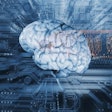
As the demand for medical imaging continues to dramatically rise, and as the complexities from the ongoing COVID-19 pandemic likely roll into the new year adding to an already overwhelming workload, many radiologists are facing a tipping point.
 Jan Makela.
Jan Makela.As the demand for medical imaging continues to dramatically rise, and as the complexities from the ongoing COVID-19 pandemic likely roll into the new year adding to an already overwhelming workload, many radiologists are facing a tipping point.
Worldwide, hospitals are performing 3.6 billion imaging procedures and producing 50 petabytes of data annually. And the burden of collecting, reading, and processing this data falls on radiologists, who amid mounting pressures, struggle to find timely and efficient methods to get their work done.
As GE Healthcare discovered in a recent survey of U.K.- and U.S.-based radiology department heads and administrators, these challenges with respect to patient overload, scheduling, and staff capacity are continuing to increase -- and were made worse by the pandemic. And they are causing wide-ranging effects, including the following:
- Staff well-being (measured in working hours) has suffered, with 32% of survey recipients noting the need to recruit more staff to reduce workload.
- Rate of turnover in radiology staff is higher than in most other departments, averaging between 11% and 20%.
- Patient satisfaction shows signs of improvement -- with healthcare providers feeling the burden of improving it even further.
The cumulative effects of these pressures are a key reason that 36% of radiologists reported they were experiencing burnout, according to a 2020 study conducted by Medscape. It's a figure that may rise further as more patients return to elective procedures -- like cancer screenings -- that were put on hold during the pandemic.
The question is: Will radiologists continue enduring daunting pressures that often carry over into their personal lives? Or will they exit the field? It's not surprising that the theme for this year's RSNA conference was "Redefining Radiology," as the shift in the industry's paradigm is well underway.
But "hanging in there" or "calling it quits" aren't the only options, of course, for overworked radiologists. Technological advancements that are intelligently efficient are poised to address many of the issues, thus ushering in a new era that may permanently -- and positively -- transform radiology by improving outcomes and curbing the practitioner burnout rate.
How can radiology become more workflow-efficient in such a fast-moving and growing environment? Leading global healthcare equipment manufacturers are leveraging artificial intelligence (AI), machine learning, and other data-oriented technologies to benefit radiologists and their key stakeholders -- especially patients and the physicians who are diagnosing and treating them.
One method to improve the efficacy of radiology workflows is through holistic PACS platforms. These diagnostic imaging and workflow solutions integrate several key facets of the work -- diagnostic reading, exam workflow, AI, 3D postprocessing, enterprise visualization, and archiving -- into a single platform. It's a great way to provide advanced functionality at an affordable cost.
Seamlessly integrating AI algorithms for multiple clinical intended uses with PACS workflow can help busy radiologists to focus their time on accurately read the right exam at the right time. New PACS applications can provide cloud-based enterprise imaging solutions and AI-based medical imaging applications that are accessible and secure, while also aiding in clinical and operational efficiencies by lowering the cost of implementation and management. These can enable remote reading anytime, anywhere to help foster delivery of more timely, personalized, and precise care.
Our studies reveal that users of these more modern PACS applications have experienced a 50% or higher increase in radiologist efficiency for certain types of exams, and they have the potential for a 90% reduction in the typical time required to adopt AI applications, due to fully hosted and managed services. Those administrative efficiencies can make cloud-based, AI-centric systems easier to adopt by smaller or budget-constrained imaging centers and community hospitals.
Other innovations are helping to reduce some of the physical burdens endured by radiologists and x-ray technologists, who can take thousands of steps each day performing some of the simplest actions within the workflow -- such as moving machinery from one location to another or repeatedly positioning the patient, both of which can lead to lengthier exams, physical exhaustion, and, ultimately, procedural errors.
With x-ray imaging accounting for 60% of all imaging studies conducted, the daily challenges of heavy lifting, repetitive motions, and other physical activities lead to more than 70% of technologists experiencing work-related injuries.
To address these problems, manufacturers are striving to automate some of the more mundane but exceedingly vital tasks by integrating efficiency tools into medical devices. For instance, many of these new systems include technology designed to be a "personal assistant" to radiologists and technologists.
Acting much like an in-room command center, this technology enables the technologist to finish all exam setup and positioning work without having to leave the patient's side. Imagine the potential impact of this highly efficient process, with respect to the goal of reducing burnout for the practitioner while optimizing the patient experience.
Finally, several technological advancements were particularly useful in handling enhanced caseloads brought about by the COVID-19 crisis. That includes innovations in the burgeoning fields of handheld imaging as well as modular imaging systems.
Wireless, pocket-sized ultrasound scanners enable crystal-clear image quality and whole-body scanning capabilities for a wide variety of clinicians who use them at the point of care to determine if additional imaging is needed, providing advantages for hospitals managing COVID-19 patients. Plus, some hospitals are applying integrated "CT in a box" capabilities to host temporary imaging units -- sometimes in hospital parking lots or other remote areas -- that are dedicated to COVID-19 patients. This frees up existing clinical facilities for other patients and helps to minimize contact with potential COVID-19 cases.
Burnout among radiologists remains a serious problem. But these and other technology-centric solutions aim to ease their physical and mental burdens, while creating new opportunities that can improve patient care through intelligently efficient practices.
Jan Makela is the president and CEO of GE Healthcare Imaging. Originally joining GE's GE Capital business in 2000, Jan previously served as President and CEO of GE Healthcare Global Services from 2017 to early 2020. He moved to GE Healthcare in 2007 to lead the Diagnostic Imaging Services business across Northern Europe, and later served as chief operations officer for GE's European region.
Jan has more than 20 years of industrial experience, beginning his career in engineering and production management with M&M/Mars, followed by leadership roles at A.T. Kearney management consultants before joining GE. He has a master's degree in engineering from the University of Cambridge.
The comments and observations expressed are those of the author and do not necessarily reflect the opinions of AuntMinnie.com.



















